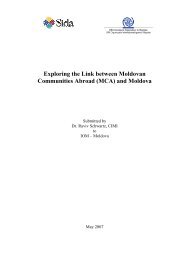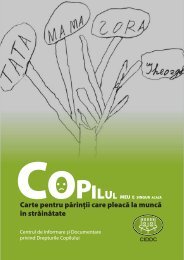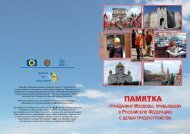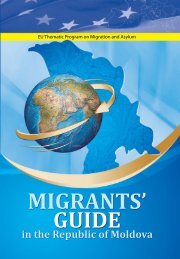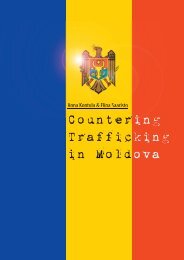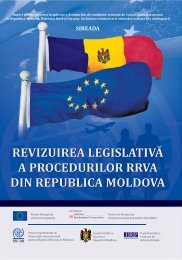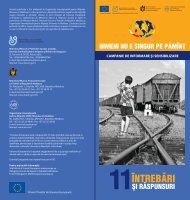Trafficking in Human Beings in Southeastern Europe - Iom
Trafficking in Human Beings in Southeastern Europe - Iom
Trafficking in Human Beings in Southeastern Europe - Iom
- No tags were found...
Create successful ePaper yourself
Turn your PDF publications into a flip-book with our unique Google optimized e-Paper software.
<strong>Traffick<strong>in</strong>g</strong> <strong>in</strong> <strong>Human</strong> Be<strong>in</strong>gs<strong>in</strong> <strong>Southeastern</strong> <strong>Europe</strong>traffick<strong>in</strong>g activities. As long as traffick<strong>in</strong>g is perceived as an issue concern<strong>in</strong>gmigrant women and anti-traffick<strong>in</strong>g activities are organised by <strong>in</strong>ternationalorganisations, there will be no real counter-traffick<strong>in</strong>g activities at the locallevel.Victim Referraland AssistanceSystem andGaps There<strong>in</strong>There has also been very little analysis of the prevention of traffick<strong>in</strong>g beyondthe very general picture of the causes of the economic and social situation ofwomen that are related to female migration. Although traffick<strong>in</strong>g often occurswith<strong>in</strong> the context of migration, it is not necessarily a result of migration itself.There has also been no analysis of the differences between adult and childtraffick<strong>in</strong>g, particularly the differences <strong>in</strong> causes and patterns of traffick<strong>in</strong>g <strong>in</strong>teenage girls under 18, young women over 18 or young children under 12.2.1. Identification and referralAccord<strong>in</strong>g to the organisations assist<strong>in</strong>g victims of traffick<strong>in</strong>g <strong>in</strong> the region, <strong>in</strong>almost all the cases that they assisted, the first po<strong>in</strong>t of contact with the traffickedwomen was through the police. The police are the first to identify traffickedwomen, usually immediately follow<strong>in</strong>g a bar raid. Although there havebeen many courses to tra<strong>in</strong> and raise the awareness of the police <strong>in</strong> the regionon traffick<strong>in</strong>g, there are no specific guidel<strong>in</strong>es for local police on the processof identify<strong>in</strong>g trafficked women and children <strong>in</strong> l<strong>in</strong>e with Palermo and other<strong>in</strong>ternational conventions.In general, the police base their selection on the follow<strong>in</strong>g categories:1.Women with valid documents (passports, visas, work visas), whomthe police have no right to question;2.Women without valid documents who can be questioned and arrestedby the police:a.those that want to return home are recognised as victims of traffick<strong>in</strong>g;b.those that do not want to return home are not recognised as victimsof traffick<strong>in</strong>g but as illegal migrants.2.1.1. Trafficked women and girls with valid documentsDur<strong>in</strong>g bar raids or rout<strong>in</strong>e controls, the police do not usually arrest, take tothe police station or <strong>in</strong>terrogate women with valid documents, i.e. those thathave valid passports and visas to stay and work legally <strong>in</strong> the country. Thisgroup is not questioned and the police have no mechanisms to identify traffickedwomen among them, unless the women request assistance at the timeof the raid. This very rarely happens because most women and girls have alanguage barrier, a lack of knowledge of their own situation and a fear of thepolice, traffickers and pimps. Girls under 18 often have false documents andpass as adults. There are no guidel<strong>in</strong>es or procedures <strong>in</strong> place that clearly outl<strong>in</strong>ethe obligation of the police to identify children under 18 and steps theyshould take to ensure that this obligation is met.Therefore, from the start, one significant group of trafficked women and girlsis not recognized as such. Accord<strong>in</strong>g to the <strong>in</strong>formation gathered from thepolice and NGOs <strong>in</strong> the region, this group constitutes approximately 30 percentof all trafficked women and girls work<strong>in</strong>g <strong>in</strong> bars and brothels. Some ofthese women are able to seek the assistance, contact the police or anembassy, but they have to do it on their own.2.1.2. Trafficked women and girls without valid documentsAccord<strong>in</strong>g to the police, IOM and local NGOs, women and girls without validdocuments constitute about 70 percent of all trafficked women and girls. This141



